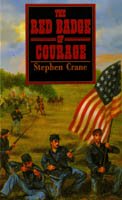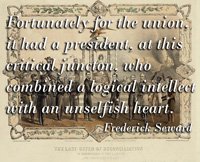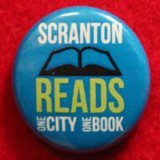Walking Into the Light at Gettysburg: A Scranton Reads Event
Written by Kitch Loftus-Mussari
Photographs by Kitch Loftus-Mussari
Copyright Mussari-Loftus Associates, LTD 2013
All Rights Reserved
Our journey to the Scranton Reads event at the Children’s Library began at Marywood University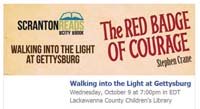 in March. Annette Fisher enjoyed Tony’s presentation about Gettysburg, Lincoln and Leadership at the 11th Annual Forum and Conference on Ethical Leadership and Corporate Social Responsibility. When he finished his talk, she asked him if he would be willing to screen the documentary he mentioned as a Scranton Reads event in the fall.
in March. Annette Fisher enjoyed Tony’s presentation about Gettysburg, Lincoln and Leadership at the 11th Annual Forum and Conference on Ethical Leadership and Corporate Social Responsibility. When he finished his talk, she asked him if he would be willing to screen the documentary he mentioned as a Scranton Reads event in the fall.
In June, Kristen Shemanski, a member of the Scranton Reads committee made the final arrangements.
Screenings by their very nature produce a lot of anxiety. Tony is a first class worrier. He always wants to maximize these events for the attendees. He spends a good deal of time anticipating questions and preparing material that will give the audience more than they expect.
For this event, he researched and read the Scranton Reads book selection, Stephen Crane’s Red Badge of Courage. Listening to him share his analysis of the book and his discoveries, I knew he was ready for the event.
Shortly after 7 p.m., Brian Fulton introduced Tony.
During his remarks, Tony expressed his gratitude to Kirsten Shemanski and the members of the committee for making the event happen. Then he explained his concept of experiential learning, and he set the stage for the screening with these words:
“If you came here to watch a film about warfare, you will be disappointed. If you came here to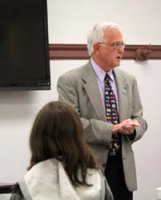 learn how a visit to Gettysburg can transform young people you will be pleased. Stephen Crane’s book is the story of Henry Fleming’s transformation during his experience on the battlefield. Our documentary is a story about the transformations that took place in the students who visited a battlefield.”
learn how a visit to Gettysburg can transform young people you will be pleased. Stephen Crane’s book is the story of Henry Fleming’s transformation during his experience on the battlefield. Our documentary is a story about the transformations that took place in the students who visited a battlefield.”
The lights dimmed, the sound of voices diminished, our company logo appeared on the screen, and the main event began.
From my seat in the back of the room, I watched both the film and the body language of the people in front of me. The audience was riveted until the lights went up.
The spontaneous applause during the credits told me the film resonated with the audience. This was made much more obvious during the Q&A session that followed. People wanted to know more about the making of the film, and they were generous in their comments about its content.
A Girl Scout from North Pocono Troop 406 said she liked the film because it explained the history of the battle at Gettysburg, and it showed how the students from North Plainfield reacted to it.
A wonderful surprise came from a couple seated in 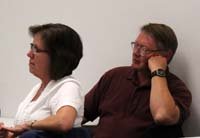 the first row. When the woman spoke, she prefaced her comments with the disclosure that she and her husband lived in North Plainfield for 32 years. She taught at the high school for 22 years, and she taught one of the students who appeared in the film. She spoke in glowing terms about the film, and she complimented the student who referred to himself as an American-Columbian during the closing scene of the film.
the first row. When the woman spoke, she prefaced her comments with the disclosure that she and her husband lived in North Plainfield for 32 years. She taught at the high school for 22 years, and she taught one of the students who appeared in the film. She spoke in glowing terms about the film, and she complimented the student who referred to himself as an American-Columbian during the closing scene of the film.
A young man in the back of the room said he enjoyed the film because he had the same reaction as the North Plainfield students when he went to Gettysburg in the late 90’s. He wanted to stay there for the rest of his life because he was awestruck by the place where the tide of the Civil War turned in 1863.
A man from Dunmore, PA, thought the film was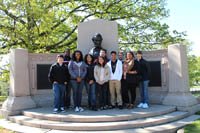 excellent and his companion noted that youngsters should learn about history in this way so they could appreciate the core values our country. For her, the film highlighted how appreciative these students, especially the ones who were not born in America, were about the freedoms Americans possess from birth. Too often, Americans take these freedoms and rights for granted.
excellent and his companion noted that youngsters should learn about history in this way so they could appreciate the core values our country. For her, the film highlighted how appreciative these students, especially the ones who were not born in America, were about the freedoms Americans possess from birth. Too often, Americans take these freedoms and rights for granted.
Referring to the current stalemate over the government shutdown and the debt ceiling crisis, Sister Mariam Pfiefer, a dear friend of ours, asked Tony to take the video to Washington right now.
Annette Fisher said she loved the way Tony incorporated all the facts and quotations about Gettysburg, Lincoln, Lee and the Civil War in subtle but effective ways throughout the film. She said she had been to Gettysburg recently, but she appreciated seeing it through someone else’s eyes.
Sister Mariam, as a finishing note, said the film was filled with the Gospel values that she has tried to cultivate and practice during her lifetime.
Turning to the Girl Scouts in the front of the room, Tony ended the evening with a comment that came straight from his heart. Referring to the students in the film and two people in the audience who have been friends for 50 years, he challenged the students in a way he has done with other students for most of his lifetime:
from his heart. Referring to the students in the film and two people in the audience who have been friends for 50 years, he challenged the students in a way he has done with other students for most of his lifetime:
“You have to start identifying your dreams now. Your dream is the anchor of your life. You should make a promise to yourself to learn something every day, and you should do an act of kindness every day. Learn to be patient, and know that the distance between your dream and your success is not a straight line. There are many bumps on the road. You must be resilient. The word resilience is not mentioned in the film, but that’s what it is all about.”
Our big night in Scranton was a night of community, confraternity celebration and learning. An adaptation of the words of Stephen Crane apply; In the community room at the Children’s Library in Scranton, we became members. We felt something of which we were a part, and we were dominated by a single desire. We wanted to learn, and we did.
May the Scranton Reads program continue to prosper and grow.
Please provide feedback to:
